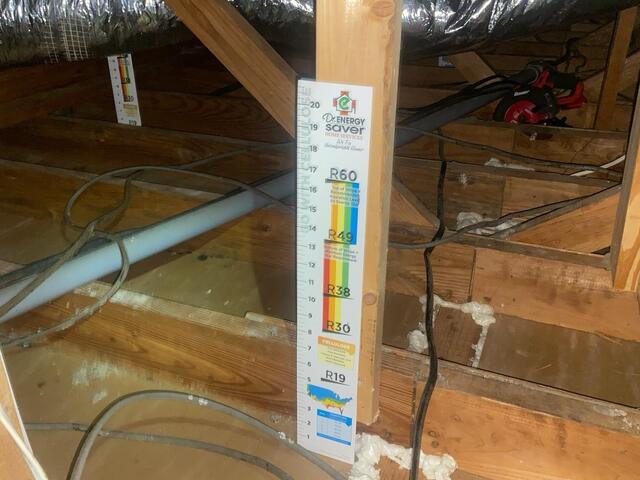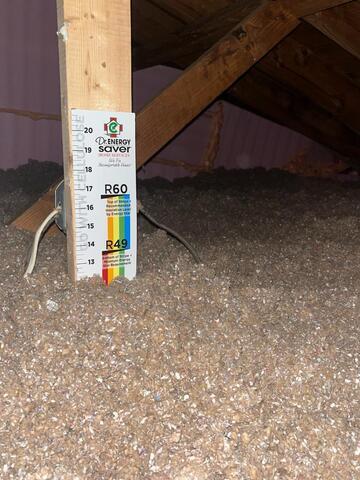Carolina Energy Conservation Before & After Photos
Click on a photo to enlarge.
Solatube in North Charleston
The North Charleston family wanted to enhance their family room by bringing in more natural light. After attending the Charleston Cajun Festival and speaking with Carolina Energy Conservation, they chose to install a Solatube as the perfect addition to their home. The Solatube's design allows for consistent bright natural light to enter the home without causing damage to the furniture and flooring. This also ensures year-round constant light as it redirects strong midday summer rays to soften the light and weak winter light to maximize brightness. As an extra feature, it also has a solar-powered nightlight that turns on automatically after the sunsets to allow extra visibility in the home, both brightening and making the home more energy efficient.
Spray Foam in North Charleston
This homeowner in North Charleston wanted to create a controlled environment within their shed. They sought help from Carolina Energy Conservation for an energy evaluation and to find the best solution. After the evaluation, it was determined that installing closed-cell spray foam was the best solution. This type of spray foam is very efficient at blocking out any air from leaking into the shed, helping to regulate the temperature. It also prevents moisture build-up, thus protecting the items inside the building. With it installed, the shed will keep consistent temperatures easier and be more comfortable throughout the seasons.
Attic Insulation in North Charleston
A family in North Charleston wanted to improve the comfort and energy efficiency of their home, so they approached Carolina Energy Conservation for help. After conducting an energy evaluation, they decided to go with polyurethane foam insulation due to its excellent performance. This type of insulation will make their home more comfortable throughout the year, improve temperature regulation, and reduce energy bills. The superior insulating properties of polyurethane foam create an airtight seal, minimizing drafts and boosting overall energy efficiency. With the insulation in place, their home can now maintain a consistent temperature, leading to improved comfort and energy efficiency.
Attic Insulation in Charleston
This homeowner in Charleston wished to boost their home’s energy efficiency by updating their attic insulation. After looking at the great reviews on Google for Carolina Energy Conservation, they opted for an energy evaluation. The evaluation revealed that the ideal solution would be to remove the old insulation and replace it with cellulose insulation to an R-38 value. Cellulose insulation, made from recycled paper products, offers excellent thermal performance and air-sealing properties, helping to maintain consistent indoor temperatures and reduce energy costs. With the insulation properly installed, their home's temperature will be more consistent and it will be much more energy efficient.
Blown-In Insulation in Charleston SC
This Charleston homeowner was concerned after noticing her home was not retaining heated air over the winter and fresh cool air over the summer. After checking the attic of her 1300sq ft ranch home, she realized their was little to no insulation in the attic that could be causing this issue. This homeowner then took to Angie's Pros listings and was referred to Carolina Energy Conservation as a top rated local installer. She gave our company a quick phone call, and within a few short business days a specialist was already out to her home inspecting the attic. Carolina Energy Conservation offered a blown-in cellulose package that more than doubled the layer of her current insulation while removing the old and deteriorated insulation.
our service area
We serve the following areas
- Bloomingdale
- Pooler
- Port Wentworth
- Savannah
- Tybee Island
- Beaufort
- Bennettsville
- Blenheim
- Bluffton
- Bonneau
- Cades
- Charleston AFB
- Clio
- Coward
- Darlington
- Daufuskie Island
- Edisto Island
- Effingham
- Florence
- Goose Creek
- Greeleyville
- Hanahan
- Hardeeville
- Hartsville
- Hilton Head Island
- Johns Island
- Kingstree
- Ladson
- Lake City
- Lamar
- Lane
- Lynchburg
- Mc Coll
- Moncks Corner
- North Charleston
- Okatie
- Olanta
- Port Royal
- Ridgeland
- Saint Helena Island
- Saint Stephen
- Salters
- Scranton
- Seabrook
- Sheldon
- Society Hill
- Summerville
- Timmonsville
- Turbeville
- Wadmalaw Island











